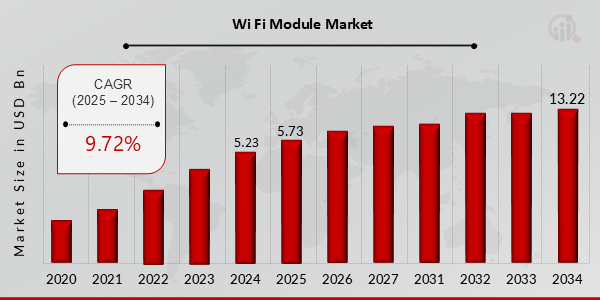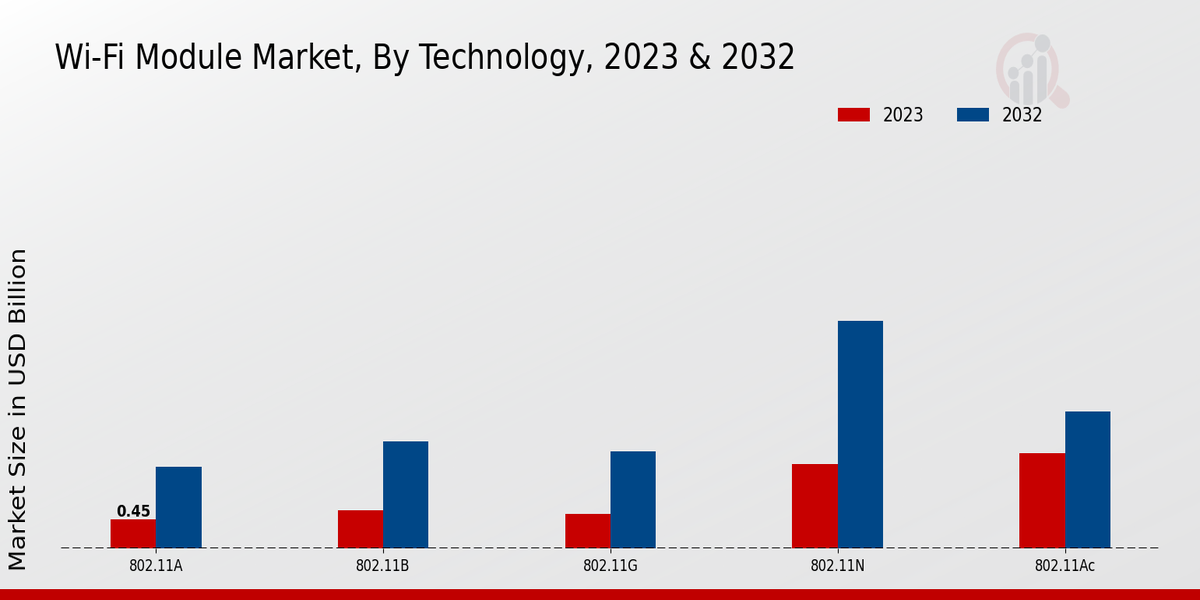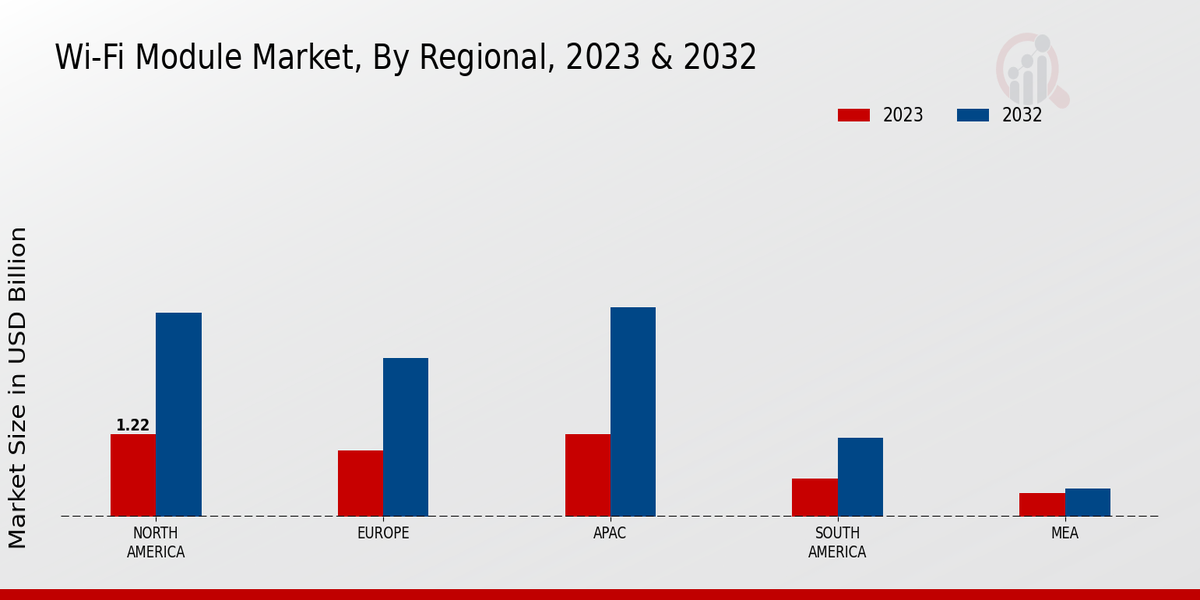Global Wi-Fi Module Market Overview
Wi-Fi Module Market Size was estimated at 5.23 (USD Billion) in 2024. The Wi-Fi Module Market Industry is expected to grow from 5.73 (USD Billion) in 2025 to 13.22 (USD Billion) till 2034, exhibiting a compound annual growth rate (CAGR) of 9.72% during the forecast period (2025 - 2034).
Key Wi-Fi Module Market Trends Highlighted
The Wi-Fi Module Market is seeing a significant shift driven by the growing demand for faster and more reliable wireless connectivity. As various industries adopt smart devices and the Internet of Things (IoT) technologies, the need for advanced Wi-Fi modules that can support high data rates and low latency is becoming increasingly important. In addition, the expansion of smart homes and smart cities enhances the demand for Wi-Fi modules with improved range and connectivity. The proliferation of mobile devices and the ongoing rollout of 5G networks are also significant factors contributing to market growth. Opportunities in the market are substantial, particularly in emerging economies where the adoption of wireless technologies is accelerating.Companies can leverage this trend by developing innovative Wi-Fi modules tailored to meet the specific needs of industries such as healthcare, automotive, and consumer electronics. Moreover, as the market progresses, there is potential for the integration of modular designs that allow for compatibility across various devices, creating more versatility and ease of use.
The focus on enhancing energy efficiency and reducing the environmental impact of these modules also presents an opportunity for manufacturers to lead in sustainability. Recent trends indicate a rise in collaboration between technology firms to optimize Wi-Fi performance and enhance features.This collaborative approach can lead to the development of multi-band Wi-Fi modules that provide better versatility and user experience. In addition, advancements in Wi-Fi standards, such as Wi-Fi 6 and beyond, are paving the way for improved performance in high-density environments. The emphasis on security in wireless connections is also becoming more critical, with manufacturers investing in advanced encryption and authentication methods to protect user data. As the market continues to evolve, adaptation to technological advancements and customer needs will be essential for success.

Source: Primary Research, Secondary Research, MRFR Database and Analyst Review
Wi-Fi Module Market Drivers
Increasing Demand for IoT Devices
The growing proliferation of Internet of Things (IoT) devices has emerged as a significant driver for the Wi-Fi Module Market Industry. As more devices become connected, there is a rising requirement for Wi-Fi modules to facilitate seamless communication and data transfer among these devices. With homes and industries increasingly adopting smart devices, such as smart thermostats, security cameras and wearables, the demand for reliable and efficient Wi-Fi connectivity is escalating.This trend is further fueled by advancements in technology, enabling faster and more reliable Wi-Fi standards. As we look toward the future, the potential integration of Wi-Fi modules in an even broader range of applications will likely enhance their importance in creating cohesive ecosystems for interconnected devices.
These developments not only improve user experiences but also foster data sharing and remote accessibility. Additionally, the push towards smart manufacturing and Industry 4.0 is compelling industries to invest in Wi-Fi modules, amplifying their significance in the market.The compounding nature of this demand reflects the anticipated growth trajectory for the Wi-Fi Module Market, suggesting that the integration of Wi-Fi technology will continue to evolve as fundamental to everyday devices.
Growing Adoption of Smart Home Technologies
The surge in smart home technologies has significantly propelled the Wi-Fi Module Market Industry. As consumers increasingly seek convenience, security and efficiency in their daily lives, smart home devices such as smart speakers, lighting controls, and home automation systems have gained popularity. These devices often rely on Wi-Fi connectivity to communicate with each other and with the users, making high-quality Wi-Fi modules indispensable.The expansion of this market is indicative of a broader trend where households are transforming into interconnected ecosystems, ultimately driving the demand for robust and reliable Wi-Fi modules.
Expansion of Wireless Connectivity Standards
The ongoing expansion of wireless standards, including advancements in Wi-Fi technology, is a crucial driver for the Wi-Fi Module Market Industry. The introduction of the latest Wi-Fi standards enhances data transfer speeds, range and connectivity capabilities. These improvements are essential for meeting the growing demands of high-speed internet and seamless connectivity in various applications, from consumer electronics to industrial Internet of Things solutions.The continued evolution of these standards makes Wi-Fi modules more appealing as they help reduce latency and increase connection stability, thereby facilitating an improved user experience.
Wi-Fi Module Market Segment Insights:
Wi-Fi Module Market Technology Insights
The Wi-Fi Module Market showcases a robust landscape that is increasingly driven by technological advancements and growing connectivity demands across various sectors. In 2023, the total market valuation was recorded at 4.34 USD Billion, reflecting a steady rise that is expected to reach 10.0 USD Billion by 2032. The segmentation of this market into distinct technological categories reveals critical insights into each segment's performance and applicability. The 802.11ac segment is noteworthy, with a valuation of 1.471 USD Billion in 2023, making it one of the leading technologies.Its ability to support high bandwidth applications makes it significant in today's data-intensive environments, thus dominating the market space. Following this, 802.11n also represents a considerable share, valued at 1.3 USD Billion in 2023; its significance stems from its widespread use in home and office networks, facilitating better coverage and speeds.
The 802.11b and 802.11g segments, while having lower valuations of 0.593 USD Billion and 0.528 USD Billion, respectively, play a vital role due to their legacy applications and established presence in older devices, thereby continuing to maintain a steady share in the market.Meanwhile, the 802.11a segment, valued at 0.447 USD Billion, finds its niche in environments where higher frequency bands are advantageous, although it remains less dominant compared to newer technologies. These values articulate the diverse applications and technology preferences that exist within the Wi-Fi Module Market, underlining the competitive dynamics at play that distinguish each technology's contribution to overall market growth. The expected continued expansion of the market, with a notable compound annual growth rate, reflects increasing consumer demand for faster and more reliable Wi-Fi connectivity solutions, driven by the proliferation of smart devices and the Internet of Things (IoT).Therefore, understanding these segmented values and market dynamics provides insight into the broader trends shaping the Wi-Fi Module Market landscape.

Source: Primary Research, Secondary Research, MRFR Database and Analyst Review
Wi-Fi Module Market Application Insights
Consumer Electronics remains a key area, with high demand driven by the proliferation of smart devices. The Automotive sector is gaining momentum, integrating Wi-Fi for enhanced connectivity and safety features. Industrial Automation benefits from robust wireless communication, which is essential for real-time data processing and operational efficiency.In Healthcare, Wi-Fi modules support critical applications like telemedicine and patient monitoring, reflecting the growing importance of connected health solutions. The Smart Home segment dominates with increasing consumer preference for IoT-enabled devices, driving integration across different systems and enhancing convenience. The evolving landscape, marked by trends in IoT and smart technology adoption, presents ample opportunities and underscores the need for innovative solutions in the Wi-Fi Module Market, with growth largely fueled by rising connectivity demands across these vital sectors.
Wi-Fi Module Market Form Factor Insights
The Form Factor segment encompasses various types, including Embedded, External and Module, each catering to distinct applications across industries. The Embedded Wi-Fi modules have gained significant traction due to their compact design and integration capabilities, making them ideal for consumer electronics and industrial applications. External Wi-Fi modules provide versatility and enhanced connectivity options, appealing largely to home and business users who demand reliable internet access.Meanwhile, the Module category often dominates the market due to its wide-ranging compatibility and easy integration into existing systems. The Wi-Fi Module Market segmentation demonstrates an evolving landscape where the increasing demand for connectivity and IoT solutions amplifies opportunities for growth, although challenges such as regulatory standards and technological integration persist. Overall, growth drivers include the rise in smart devices and the growing emphasis on IoT-enabled applications, fostering a dynamic market environment as indicated by the Wi-Fi Module Market statistics.
Wi-Fi Module Market End Use Insights
In terms of End Use, the market is primarily divided into Residential, Commercial and Industrial applications, each contributing uniquely to the overall market dynamics. The Residential segment is a major driver of demand, attributed to the increasing number of smart home devices and the growing trend of home automation. The Commercial sector also plays a vital role, especially with the rise of IoT in business environments, enhancing connectivity for operations and customer engagement.Furthermore, Industrial end use is gaining momentum, highlighting the adoption of Wi-Fi modules in manufacturing and logistics for improved operational efficiency. The Wi-Fi Module Market statistics show that each segment faces its share of challenges, such as cybersecurity threats and the need for continuous innovation. However, the opportunities for market growth are substantial, considering the increasing reliance on wireless communication technologies across various sectors. Overall, the Wi-Fi Module Market data reflects a robust trend toward smart connectivity, positioning it as a key area for future investment and development.
Wi-Fi Module Market Regional Insights
North America holds a majority share, valued at 1.219 billion USD in 2023, representing a significant demand driven by advanced technological infrastructure and a growing adoption of smart devices. Europe follows closely, with a valuation of 0.975 billion USD in 2023, reflecting the region's strong focus on connectivity innovations. The APAC region is equally notable, matching North America's value with 1.219 billion USD in 2023, supported by increasing internet penetration and the rise of IoT applications.South America, although smaller, presents growth potential with a value of 0.569 billion USD in 2023 as online engagement surges. Meanwhile, the MEA region, while valued at 0.358 billion USD in 2023, is gradually witnessing an uplift due to expanding wireless networks and digitalization efforts. The diverse regional landscape illustrates the varying growth drivers, challenges, and opportunities, making the Wi-Fi Module Market a dynamic and evolving sector.

Source: Primary Research, Secondary Research, MRFR Database and Analyst Review
Wi-Fi Module Market Key Players and Competitive Insights:
The Wi-Fi Module Market is characterized by rapid growth and increasing competition as numerous companies strive to capture a larger share of this expanding sector. The market is influenced by technological advancements and a rise in the demand for connected devices across various applications, including consumer electronics, automotive, healthcare and industrial automation. Competitive insights within this market reveal that companies continuously invest in research and development to innovate and enhance their Wi-Fi solutions, catering to emerging trends such as the Internet of Things (IoT) and smart home technologies. As more industries rely on wireless connectivity, understanding the competitive dynamics among leading players becomes essential, highlighting their strategies, strengths and market positions.Nordic Semiconductor holds a prominent position in the Wi-Fi Module Market due to its robust focus on low-power wireless solutions tailored for IoT applications.
The company is renowned for its cutting-edge technology, which facilitates seamless connectivity in battery-operated devices. Nordic Semiconductor's strength lies in its ability to offer comprehensive development kits that allow developers to accelerate product design and implementation. Their products are recognized for high efficiency, reliability, and ease of integration into existing systems, making them a preferred choice for various applications. Notably, Nordic Semiconductor fosters a strong developer community, which enhances support and collaboration, ultimately boosting its influence within the market.Texas Instruments stands as a significant player in the Wi-Fi Module Market, leveraging its extensive portfolio of semiconductor solutions and expertise in embedded processing. The company is well-known for its innovative Wi-Fi modules designed to empower a wide range of applications, from industrial and automotive sectors to consumer electronics.
Texas Instruments emphasizes energy efficiency and performance in its products, ensuring reliable connectivity while minimizing power consumption. With a strong market presence bolstered by its global distribution network and a dedicated customer support system, Texas Instruments continually aims to meet the evolving demands of connected applications. The company's commitment to innovation and customer satisfaction further cements its reputation as a leading provider of Wi-Fi solutions tailored for diverse markets and industries.
Key Companies in the Wi-Fi Module Market Include:
- Nordic Semiconductor
- Texas Instruments
- Skyworks Solutions
- Roku
- Qualcomm
- Cypress Semiconductor
- Harman International
- LiteOn Technology
- Espressif Systems
- Mediatek
- Analog Devices
- NXP Semiconductors
- Broadcom
- Marvell Technology
- Microchip Technology
Wi-Fi Module Market Industry Developments
Recent developments in the Wi-Fi Module Market have shown significant advancements and investments from key players like Nordic Semiconductor, Texas Instruments and Qualcomm, focusing on enhancing connectivity solutions across various sectors. Texas Instruments recently introduced new Wi-Fi module solutions designed for industrial applications, emphasizing reliability and security. Likewise, Qualcomm is expanding its Wireless Edge portfolio to cater to the growing demand for IoT connectivity, while Espressif Systems launched innovative low-power Wi-Fi chips designed for energy-efficient applications. Additionally, mergers and acquisitions are shaping the landscape of the market, with Cypress Semiconductor being acquired by Infineon Technologies, which has generated interest in their combined expertise in connectivity. Similar activities are expected from other major corporations in the sector such as Broadcom and Marvell Technology, aiming to consolidate market positions. Market valuations of these companies have seen upward trends, significantly impacting the overall market growth as demand for Wi-Fi modules increases across consumer electronics, automotive, and smart home applications. The competitive landscape continues to evolve with technological innovations and strategic partnerships driving the Wi-Fi Module Market forward.
Wi-Fi Module Market Segmentation Insights
-
Wi-Fi Module Market Technology Outlook
-
Wi-Fi Module Market Application Outlook
- Consumer Electronics
- Automotive
- Industrial Automation
- Healthcare
- Smart Home
-
Wi-Fi Module Market Form Factor Outlook
-
Wi-Fi Module Market End Use Outlook
- Residential
- Commercial
- Industrial
-
Wi-Fi Module Market Regional Outlook
-
North America
-
Europe
-
South America
-
Asia Pacific
-
Middle East and Africa
| Report Attribute/Metric |
Details |
|
Market Size 2024
|
USD 5.23 Billion
|
|
Market Size 2025
|
USD 5.73 Billion
|
|
Market Size 2034
|
USD 13.22 Billion
|
|
Compound Annual Growth Rate (CAGR)
|
9.72% (2025-2034)
|
| Report Coverage |
Revenue Forecast, Competitive Landscape, Growth Factors, and Trends |
|
Base Year
|
2024
|
|
Market Forecast Period
|
2025-2034
|
|
Historical Data
|
2020-2023
|
| Market Forecast Units |
USD Billion |
| Key Companies Profiled |
Nordic Semiconductor, Texas Instruments, Skyworks Solutions, Roku, Qualcomm, Cypress Semiconductor, Harman International, LiteOn Technology, Espressif Systems, Mediatek, Analog Devices, NXP Semiconductors, Broadcom, Marvell Technology, Microchip Technology |
| Segments Covered |
Technology, Application, Form Factor, End Use, Regional |
| Key Market Opportunities |
Increasing IoT device adoption,Growth in smart home deployment, Expansion in automotive connectivity, Demand for enhanced industrial automation, Rising focus on wireless healthcare solutions |
| Key Market Dynamics |
Growing IoT adoption, Increasing demand for connectivity, Advancements in wireless technology, Rising smart home devices, Need for cost-effective solutions |
| Countries Covered |
North America, Europe, APAC, South America, MEA |
Frequently Asked Questions (FAQ) :
The Wi-Fi Module Market was expected to be valued at 13.22 USD billion by 2034.
The expected CAGR for the Wi-Fi Module Market from 2025 to 2034 is 9.72%.
North America is projected to have the largest market share in the Wi-Fi Module Market, expected to reach 3.0 USD billion by 2032.
The 802.11ac technology segment is expected to be valued at 2.1 USD billion by 2032.
Major players in the Wi-Fi Module Market include Nordic Semiconductor, Texas Instruments, and Qualcomm, among others.
The APAC region is expected to see its market size grow to 3.083 USD billion by 2032.
The market size for the 802.11n technology segment is projected to reach 3.5 USD billion by 2032.
The market value of the Wi-Fi Module Market is anticipated to increase significantly following the growth trajectory established in 2023.
The 802.11b technology segment is projected to be valued at 1.65 USD billion by 2032.
Challenges such as market competition and technological advancements are anticipated to influence the Wi-Fi Module Market growth.

















